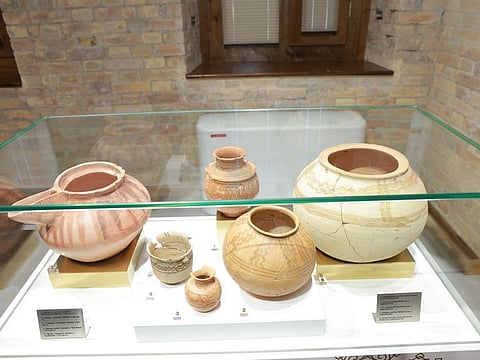‘Treasures from Sharjah’ expo in Samarkand spotlights emirate’s historic role in 'Silk Route' trade
Exhibition boosts cultural ties with Uzbekistan, showcasing Sharjah’s rich heritage

Sharjah: The exhibition “From the Arabian Peninsula to Central Asia: Treasures from Sharjah on the Silk Road,” organised by the Sharjah Antiquities Authority in partnership with Uzbekistan’s Ministry of Environment, Environmental Protection and Climate Change, concluded successfully on Wednesday at the Silk Road House of Arts in Samarkand, Uzbekistan.
Opening on April 18, 2024, the exhibition attracted significant interest from residents and visitors due to its unique displays.
It highlighted the rich history, cultural heritage, and strong connections between the Arabian Peninsula and Central Asia.
Celebrating history
The Sharjah exhibition, held in the historical city of Samarkand, featured 121 distinctive artefacts that encapsulate the rich cultural and archaeological heritage of the Emirate, celebrating its historical past as well as the vibrant present.
The exhibition was spread over three main halls at the Silk Road House of Arts.
The exhibition offered a rare opportunity for visitors to get a peek into the Arab and Islamic cultural heritage of the Emirate of Sharjah, its diversity and its history, which is reflected in the showcasing of the emirate and its status as an ever charming and diverse cultural and tourist destination.
Wide turnout
The ‘Treasures from Sharjah’ exhibition received a robust response from Uzbek students and educational institutions, thanks to the initiative of the Ministry of Environment, Environmental Protection and Climate Change to allocate 10 buses daily to transport students to the exhibition centre.
The students were presented with the opportunity to explore more than 120 rare artefacts, representing the shared history and cultural heritage of the Arabian Peninsula and Central Asia.
Deep cultural imprint
The Sharjah exhibition is destined to play a key role in strengthening cultural relations between Sharjah and Uzbekistan, exchanging vital expertise and experience in the field of archaeological heritage preservation.
In a gesture of cooperation, the Sharjah Antiquities Authority gifted all the display boxes in the exhibition, in addition to the model of the Mleiha Palace and the model of the Tomb of Al-Buhais, to Samarkand University.
The exhibition left its cultural mark among visitors and introduced the rich history and cultural relations between the peoples of the Arabian Peninsula and Central Asia that go back centuries.
Continue cultural efforts
The Sharjah Antiquities Authority, through the exhibition, reaffirmed its commitment to promoting culture and awareness of the importance of archaeological heritage, by organising international exhibitions that highlight archaeological discoveries from the Emirate and enhance cultural cooperation with other countries.
The initiative was part of the authority’s archaeological exhibitions program at the national and international levels, in order to highlight the existing scientific studies and research at archaeological excavation sites.
Insights
The exhibition spotlighted the story of centuries of passage and communication on the historical Silk Road and the importance of Samarkand as a historical city on this route.
It also provided insights into the commercial role played by the city of Mleiha in the Emirate of Sharjah in the first century BC through its displays of pottery collections discovered in Mleiha.
The exhibition constituted three halls featuring rare exhibits from the Stone Age, the Bronze Age and Iron Age periods, in addition to the exhibits from the Islamic golden age.
Sign up for the Daily Briefing
Get the latest news and updates straight to your inbox



